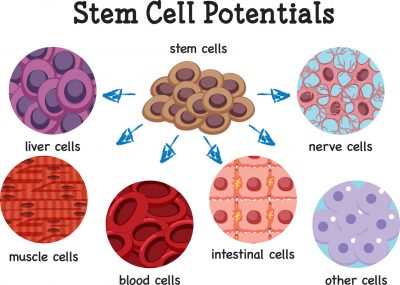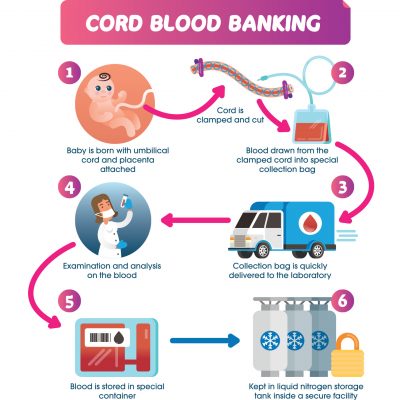Cord blood? Stem cells? Have you heard of these terms before? What about cord blood stem cell transplant? Did you know that this procedure can be used to treat up to 80 diseases?
The basic terms
Before we proceed to learn more about cord blood stem cell transplant, here’s a primer on some important terms you should know:

- Stem cells: A type of cells with the potential to develop into many different types of cells in the body. Stem cells serve as a repair system for the body. They function to replace, repair or regenerate damaged cells, for example, brain cells, cardiac cells, etc. Pluripotent stem cells can be found in bone marrow, peripheral blood and cord blood.
- Cord blood: The blood from the baby that is left in the umbilical cord and placenta after birth. Cord blood is rich in haematopoietic stem cells (HSCs), special blood-forming stem cells that are similar to those found in bone marrow. HSCs are primarily responsible for replenishing blood and regenerating the immune system. These precious stem cells may be preserved for later use in medical therapies.
Cord blood stem cell transplant
Firstly, stem cell transplant is a procedure taken to replace damaged blood cells with healthy ones, particularly when the bone marrow is damaged and no longer capable of producing healthy blood cells. The procedure is also carried out to replace damaged or destroyed blood cells after an intensive cancer treatment.
There are two types of stem cell transplants: 1) allogeneic (using matching stem cells from another person), and 2) autologous (using your own stem cells extracted earlier). Cord blood is one of the sources for stem cell transplant. Other sources are bone marrow and peripheral blood.
Proven and emerging applications
Cord blood stem cell transplant has been approved by the Food and Drug Administration as standard care treatment for nearly 80 diseases and approximately more than 40,000 transplants have been conducted over the past 30 years since the first transplant in 1988.
Cord blood stem cell transplant is most commonly used to treat blood disorders, such as leukaemia, thalassemia, lymphoma and anaplastic anaemia. It has also been used to treat various genetic illnesses, such as:

Even though the use of peripheral blood stem cells has been increasing in recent years, thus reducing the roles of cord blood stem cells in certain areas, research is also on-going to explore the potential use of cord blood stem cells in new medical applications, such as in cellular therapy and regenerative medicine for autism, cerebral palsy, spinal cord injury, hearing loss, diabetes and more.
The following real life story demonstrates a successful cord blood stem cell transplant:
Patient story: Surviving leukaemia
Maria, a young mother, was devastated when her sweet little girl, Anna, was diagnosed with acute myeloid leukaemia at the age of 12 months. During the initial assessment, doctors had only given her less than 10% chance of survival and her little body was suffering terribly due to the cancer.
On top of that, Maria also found out that she was pregnant with her second child. Due to stress and desperation in her effort to find cure for Anna, Maria even considered abortion and consulted different doctors.
By chance, a gynaecologist advised her not to proceed with the abortion and brought a glimmer of hope in curing her daughter when she introduced Maria to “cord blood stem cell transplant”. Anna may stand a chance to survive if she can undergo a cord blood stem cell transplant using her younger sibling’s stem cells, provided that Anna lived long enough until the birth of her baby brother and that his cord blood stem cells were a match for her.
Finally, Maria gave birth to Isaac and his cord blood stem cells were collected at birth for long-term storage. The good news was they were a good match for Anna. Maria and her husband were so glad to receive the news. Two months after that, the stem cell transplant was conducted successfully. Little by little, Anna managed to regain her health and her life was saved, all thanks to her little brother’s gift of cord blood stem cells.
Note: Names and details have been changed to protect their privacy.
Cord blood banking

Cord blood banking refers to a process of collecting potentially life-saving stem cells from the umbilical cord and placenta of a newborn and storing them for future medical use. The cord blood will be collected after birth from the umbilical vessels and placed into a collection bag, which then will be packaged and sent to a cord blood bank. At the cord blood bank, the cord blood will be cryopreserved for long-term storage.
In Malaysia, the National Blood Bank has established a public cord blood bank where parents can donate their children’s cord blood for public use. It has been operating since 2001 until the end of 2021, mainly in collaboration with Kuala Lumpur General Hospital. New donations are no longer collected currently, but collected units are still preserved.
Multiple successful transplants using the stored cord blood have been performed, for example involving patients with aplastic anaemia, Fanconi’s anaemia, acute myeloid leukaemia and acute lymphoblastic leukaemia.
A number of local private cord blood banks are also available, where parents can store their children’s cord blood for personal use. Private cord blood banking is an option to consider for families with a history of malignant or genetic conditions treatable with stem cell transplants. Cord blood from a family member has a higher chance of match for transplant compared to a stranger’s cord blood.
For example, siblings have a 25% chance of being a perfect match and 50% chance of partial match. If stem cells are required as part of the treatment for your loved ones’ illnesses, the cord blood will be readily available and you don’t have to look for a donor.
Should you store all your children’s cord blood?
Multiple cord blood banking means storing cord blood from different members of the family. Storing every child’s umbilical cord blood gives you more options because you will not know which unit will match which sibling if an allogeneic transplant is required.
Furthermore, a downside to cord blood is that it is limited and cannot be extracted multiple times. So, having multiple cord blood stored may be necessary if you need reserve sources in case of transplant failure or disease relapse.
Cord blood stem cell transplant is part of medical progress that has saved the lives of many patients. For families at risk of certain illnesses, it may be an option to consider in future. Consult your doctor to learn more about the procedure and the necessary steps. If you decide to store your child’s cord blood, be prepared in advance before the date of delivery.






Comments